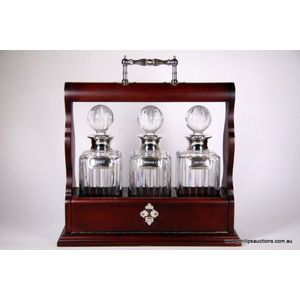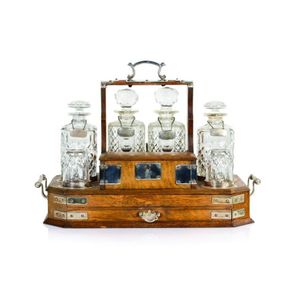Late-Victorian Oak Butlers Tray Tantalus with Glass Decanters
You must be a subscriber, and be logged in to view price and dealer details.
Subscribe Now to view actual auction price for this item
When you subscribe, you have the option of setting the currency in which to display prices to $Au, $US, $NZ or Stg.
- Tantalus - A tantalus is a container for holding two or three glass or crystal bottles of alchoholic drinks. A tantalus may take various forms, the most common being made from silver, silver plate or wood with the three bottles in a circle or two bottles in line with a central handle. A larger version has three bottles in a line with two end supports and a horizontal top and handle. To prevent unauthorised access, some tantalus have a locking mecahnism that prevents the bottles and stoppers being removed from the bottles when secured.
A box tantalus, as the name implies is an elaborate wooden box made of a fancy timber such as coramandel, with divisions for the bottles and a lockable lid. Some of these type are designed for liquers and include the liquer glasses set into fitted holders. - Oak - Native to Europe and England, oak has been used for joinery, furniture and building since the beginning of the medieval civilisation. It is a pale yellow in colour when freshly cut and darkens with age to a mid brown colour.
Oak as a furniture timber was superceded by walnut in the 17th century, and in the 18th century by mahogany,
Semi-fossilised bog oak is black in colour, and is found in peat bogs where the trees have fallen and been preserved from decay by the bog. It is used for jewellery and small carved trinkets.
Pollard oak is taken from an oak that has been regularly pollarded, that is the upper branches have been removed at the top of the trunk, result that new branches would appear, and over time the top would become ball-like. . When harvested and sawn, the timber displays a continuous surface of knotty circles. The timber was scarce and expensive and was used in more expensive pieces of furniture in the Regency and Victorian periods.
This item has been included into following indexes:
Visually similar items

A sterling silver and crystal tantalus, with wine labels, 2003/4 Sheffield, with Tudor rose town mark and maker's mark for Whitehill Silver & Plate Co; and wine labels 1979 London, with maker's marks for Richards & Knight, three elegant square section deca

A brass Congreve rolling ball clock, the four-pillar frame with tilting table to accommodate the balls surmounted by the skeleton fusee movement with three enamel annular dials, raised on a 'Sorrento' inlaid walnut plinth base with drawer and enclosed with

An outstanding quality signed 19th century French buffet sideboard of palace size, walnut with parquetry inlaid decoration, sculptured ormolu mounts. The lower section fitted with two parquetry panelled central doors, open side shelves, fitted with four ce

Oak 2 decanter tantalus, with silver plated fittings and key lock, 29 cm wide, 31 cm high
